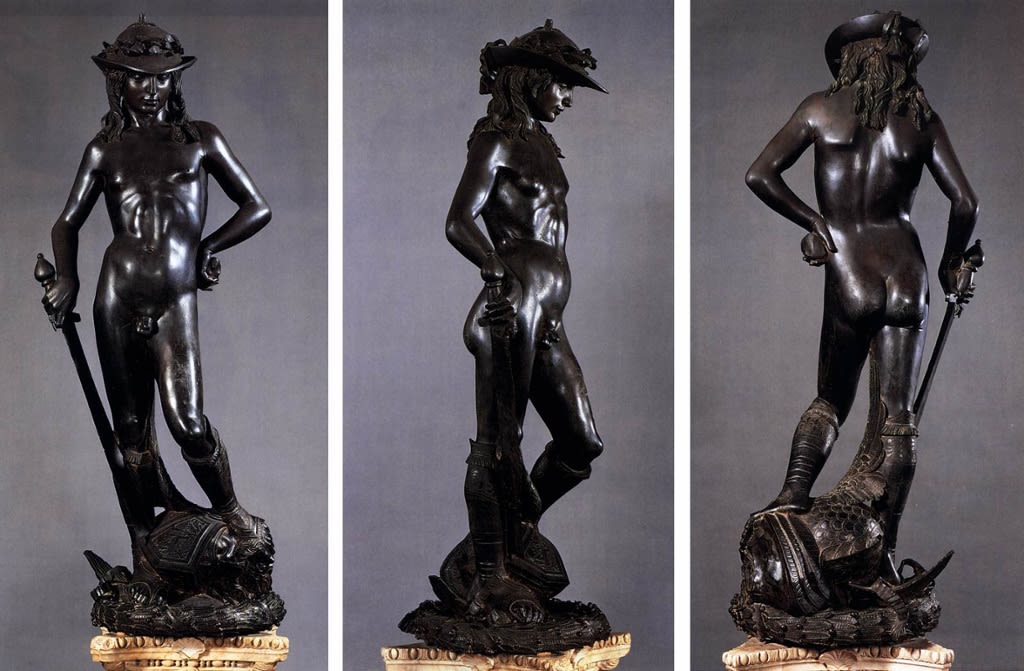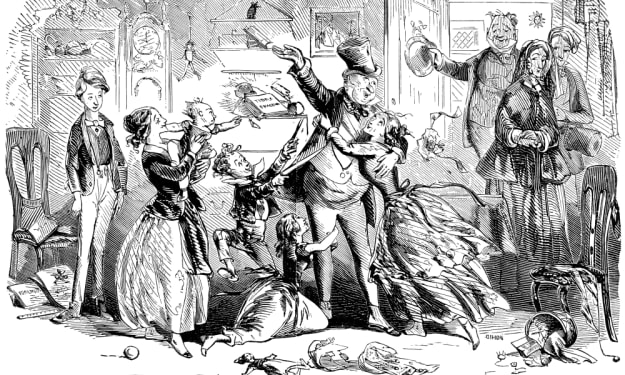Donatello's statue of David
A very different interpretation to that of Michelangelo

Donatello (full name Donato di Niccolò di Betto Bardi) was probably born in 1386 (in Florence) and was apprenticed to the sculptor and goldsmith Lorenzo Ghiberti, with whom he worked on a number of commissions for statues to adorn churches and other buildings in Florence. He also spent three years in Rome working for the architect Filippo Brunelleschi.
He soon developed his own style, which was more natural and realistic than that of his predecessors. Both in statuary and bas-relief, his figures were not just monuments but representations of real people caught at a moment of action, whether laughing, grimacing, leaping or twisting. His bas-relief of “Herod’s Feast” (dated 1427) captures the moment when Herod is presented with the head of John the Baptist and the diners react with varying expressions of horror.

His bronze statue of David (probably dating from 1440) holds an important place in the history of sculpture because it was the first nude statue since antiquity (as far as we know) to be designed to be free-standing, as opposed to occupying a place in a niche. It was therefore intended to be appreciated from all angles because the viewer can walk round it rather than merely viewing it from the front.
When we think about statues of David we immediately bring Michelangelo’s iconic image to mind, so it is interesting to compare it with Donatello’s work, completed more than 60 years before Michelangelo’s. For one thing, Donatello’s David is nowhere near as massive, being only five feet high as opposed to seventeen. For another, although both figures are completely nude, Michelangelo’s David is a heroic warrior looking out into the far distance, whereas Donatello’s is a shepherd boy contemplating the object at his feet, namely the severed head of Goliath.
Both Davids are shown with the weight thrown on to the right leg, with the left bent at the knee, but Donatello’s is far more flexed than Michelangelo’s. The right hip is much higher than the left, creating a curve through the entire body, and the left hand rests on the hip with the arm bent at the elbow. The right arm holds the hilt of the sword, the point of which touches Goliath’s head.
Donatello’s David has long hair that trails to his shoulders and he wears a broad-brimmed hat that is decorated with laurel leaves. His body does not appear to be as strong as Michelangelo’s David, with no arm muscles to speak of. It is also completely hairless, without even the public hair of Michelangelo’s work. This is very much a young boy, as opposed to a man, and is therefore more faithful to the Biblical account. However, one might wonder whether so slight a lad would have had the strength to wield a sword as massive as the one he is holding.
When Vasari wrote about this bronze in 1568 he commented that it was “so natural and possesses such beauty that it seems incredible that it was not moulded upon a living body”. This is entirely possible, and leads us on to slightly darker thoughts, because we know that Donatello was homosexual.
Donatello never tried to hide his homosexuality, but little is known about his private life either. There is no record of any scandal attaching to the sculptor, so perhaps he was very discreet about his sexual relationships or they were tolerated by those around him. Whatever the facts may be, knowledge of his sexuality goes a long way to explain how he saw his David. This is a body that he clearly admires, not just as a representation of a classic hero but as a sensual form that invites the viewer to come closer. The stance is almost coquettish, and therefore shocking when one realises that this young, attractive male has just cut the head off a giant.
Michelangelo gave us a hero, but Donatello offers a figure of beauty, seen from his viewpoint as an object of desire. To us today there is something disturbing about it, as we wonder what relationship the sculptor may have had with his model. Can we allow ourselves to admire this work, knowing that it might be telling a story of the abuse of a pre-pubescent boy by a man of 45?
This work therefore poses questions about how we view art; should we talk about “art for art’s sake” or can we only appreciate a work fully if we enter the mind of the artist and attempt to view it as he did? When we do the latter, do we then sometimes have second thoughts about the moral standing of the work itself?
The statue can be seen in the Bargello Museum in Florence and there is a plaster copy, but with the sword broken off, in London’s Victoria and Albert Museum.
About the Creator
John Welford
I am a retired librarian, having spent most of my career in academic and industrial libraries.
I write on a number of subjects and also write stories as a member of the "Hinckley Scribblers".






Comments
There are no comments for this story
Be the first to respond and start the conversation.